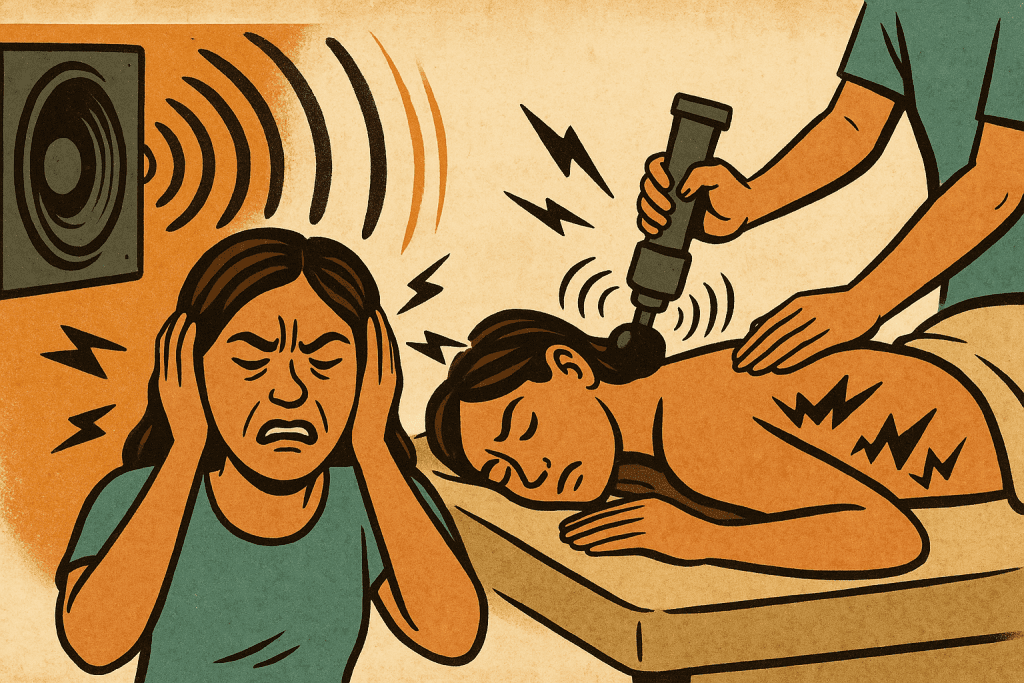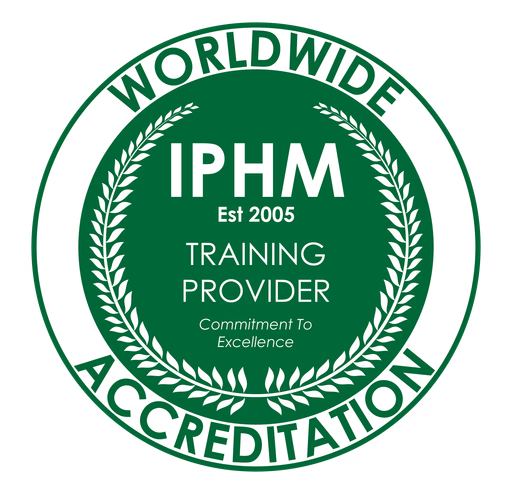
Sound and vibration therapies can feel like a spa day for your nervous system until they don’t. While many people leave a sound bath or vibroacoustic session feeling light, grounded, and deeply rested, others can experience dizziness, headaches, ringing in the ears, or just “too much” stimulation. If you’re wondering what the real risks are (and how to avoid them), this guide breaks it down in plain language.
Quick note: Nothing here is medical advice. If you have a health condition or any implants/devices, talk to your clinician before trying these therapies.
A Quick Overview: What These Therapies Are (and Aren’t)
Sound massage vs. vibration massage
- Sound massage / sound therapy: Uses sound waves from instruments like Himalayan singing bowls, crystal bowls, gongs, chimes, or recorded frequencies to create a “bath” of sound. Sometimes bowls are placed on the body so you feel gentle vibration.
- Vibration massage / vibroacoustic therapy: Uses chairs, mats, or beds with embedded transducers that deliver low-frequency vibrations through the body. Localised vibration can be used to target specific muscles or body parts for focused therapeutic effects, making it effective for treating isolated areas where stretching is difficult. Think of it as a “subwoofer for your fascia.”
- Percussive massage (massage guns): Not strictly “sound therapy,” but a lot of people group it in because it’s mechanical vibration rapid pulses that can reach deep tissues.
Common tools (bowls, gongs, tuning forks, chairs, beds, massage guns)
Each tool comes with its own profile of intensity, frequency range, and potential side effects. Bowls and gongs can be surprisingly loud at close range. Tuning forks deliver focused vibration to specific points. Vibroacoustic beds/chairs distribute lower frequencies more evenly. Massage guns add forceful percussion that can be too much for inflamed or fragile tissues.
Safety Snapshot
Who should avoid or get medical clearance first
- People with pacemakers/ICDs or other implanted electronic devices
- Those with cochlear implants or hearing aids (extra caution)
- Anyone with a history of seizures/epilepsy
- Pregnant individuals (especially first trimester)
- People with recent surgery, unhealed fractures, acute injuries, or DVT/active clotting issues
- Those on anticoagulant medications or with bleeding disorders
- People with severe osteoporosis, active infection, open wounds, or skin conditions at contact sites
When to stop immediately
If you feel sharp pain, spinning dizziness, chest discomfort, numbness/tingling, ringing that persists, panic, or visual changes, speak up and stop the session. Your body is giving you data listen.
How Risks Arise: Volume, Frequency, Amplitude, and Duration
Loudness and hearing health
Even “relaxing” instruments can spike to uncomfortable levels when placed near the head or struck forcefully. Prolonged exposure to loud sound may aggravate tinnitus or cause temporary threshold shifts (your hearing dulls). Keep bowls, gongs, and speakers at a respectful distance from ears.
Low frequencies and body resonance
Low-frequency vibrations interact with the human body by affecting various tissues and systems, which can lead to both soothing and adverse effects. Low-frequency vibrations can feel soothing, but in some people they provoke nausea, head pressure, or lightheadedness especially if there’s a history of migraine or vestibular disorders (e.g., Menière’s).
Intensity and exposure time
Like sun exposure, it’s about dose. High intensity for a long time ramps up risk. Start mild, go slow, and pause if your body says “enough.”
Short-Term Side Effects You Might Notice
Headache, fatigue, nausea, dizziness
These are the big four. They can happen when volume is too high, the instrument sits directly on sensitive areas, or the session runs too long without breaks. Hydration and fresh air often help post-session.
Anxiety or overwhelm in sound baths
Gongs and layered drones can be emotionally intense. People processing trauma or those with sensory sensitivity may feel trapped, startled, or flooded. It’s okay to lie near the exit, use earplugs, or step out.
Ear & Hearing Considerations
Tinnitus flare-ups and ear sensitivity
Close-range gongs or bowls near the head may trigger ringing or ear pressure. If you already have tinnitus or hyperacusis, ask the facilitator to keep instruments well away from your head and avoid sudden crescendos.
Ear infections or blocked ears
If your ears are congested or infected, resonance can feel like pressure. Wait until you’ve healed or keep intensity very low.
Neurological Considerations
Migraine history
Certain frequencies or repetitive pulses can kick off a migraine in susceptible people. Dim lights, slower pacing, and lower intensity help. Let your practitioner know your triggers.
Epilepsy and seizure thresholds
Vibrations and rhythmic visual environments can lower thresholds for some individuals. If you have epilepsy, seek a clinician’s clearance and work only with practitioners who will tailor frequency, volume, and duration conservatively.
Cardiovascular & Circulatory Risks
Anticoagulants and easy bruising
If you bruise easily or take blood thinners, avoid percussive tools or strong local vibration over bony prominences and thin tissues. Gentle, broad, and indirect approaches are safer.
DVT, varicose veins, and recent surgery
Avoid direct vibration over suspected clots, inflamed veins, or post-surgical sites. Vibration can theoretically dislodge clots or worsen inflammation this is a hard stop area.
Pregnancy & Postpartum
First trimester caution
Because the first trimester is delicate, many providers avoid sound on the abdomen or lower back, and keep overall intensity low. When in doubt, skip or get medical guidance.
Abdominal and lower-back exposure
Direct vibration on the abdomen or sacrum is typically avoided during pregnancy. Calming, distant sound fields may be acceptable with clearance and a skilled practitioner.
Implants, Devices, and Metal in the Body
Pacemakers and implanted defibrillators
Electromagnetic fields and strong mechanical vibration can interfere with devices. Do not place vibratory tools near the chest of someone with a cardiac implant; get written clearance first.
Cochlear implants, hearing aids, and dental work
Close-range bowls/gongs can create uncomfortable resonance for people with hearing devices or extensive dental restorations. Keep distance, reduce volume, and communicate continuously.
Bones, Joints, and Soft Tissue
Fractures, osteoporosis, acute injuries
Fragile bones don’t appreciate force. Avoid direct vibration on healing fractures, osteoporotic zones, or fresh sprains/strains. Vibration can aggravate inflammation or delay healing if overdone.
Massage guns and overuse risks
Massage guns are great until they’re not. Risks include bruising, nerve irritation, bursitis flare-ups, or even rare rhabdomyolysis with extreme overuse. Never use them over neck carotid areas, bony landmarks, fresh tattoos, varicose veins, or numb regions. Keep sessions short, light, and targeted.
Mental Health & Trauma Sensitivity
Startle responses and dissociation
Sudden gong strikes or deep drones can trigger fight-or-flight. People with PTSD, autism spectrum sensory sensitivities, or panic disorder may need predictable pacing and control (e.g., a “raise your hand to pause” signal).
Creating psychological safety
- Share a pre-session plan: what instruments, how long, how loud.
- Offer opt-out choices: earplugs, distance, chair instead of floor.
- Invite check-ins: “How’s this intensity on a scale of 1–10?”
Children, Older Adults, and Other Special Populations
Adjusting intensity and session length
Kids and older adults often need shorter sessions and gentler intensity. For people with cognitive impairment or communication challenges, use clear consent cues and frequent check-ins.
Comparing Modalities: Which Ones Carry More Risk?
Singing bowls & gongs
- Risks: sudden loud peaks, tinnitus flare-ups, startle responses
- Tips: keep distance from the head, favor softer mallets, and build gradually rather than slamming a crescendo.
Tuning forks
- Risks: local discomfort if pressed hard; avoid bony prominences and open wounds
- Tips: use light touch, short applications, and avoid placing forks near implants or over carotid arteries.
Vibroacoustic beds & chairs
- Risks: dizziness, nausea in vestibular-sensitive people; contraindicated in DVT, acute infections, or post-op sites
- Tips: start at low intensity, keep sessions 10–20 minutes at first, and document medical history. For some whole-body vibration treatments, using a vibrating platform in a half squat position can help maximize therapeutic effects.
Percussive massage guns
- Risks: bruising, nerve irritation, aggravating tendinopathies, rare severe muscle breakdown with misuse
- Tips: avoid neck front, spine, kneecaps, and elbows; keep to 30–90 seconds per area, lowest effective setting.
Hygiene & Infection Control
Shared equipment and skin contact
Mats, bowls placed on the body, tuning forks, and gun attachments should be cleaned between clients. Avoid contact over broken skin, rashes, or active infections.
Red Flags During a Session
Symptoms that mean “pause or stop”
- Sharp or escalating pain
- Ringing in the ears that persists or worsens
- Spinning dizziness or nausea
- Numbness, tingling, or unusual weakness
- Chest pressure or shortness of breath
- Panic or intense emotional distress
It’s your session you can stop anytime. A good practitioner will support that choice.
How to Minimize Risk (Practical Checklist)
Screening questions
Before you begin, share:
- Heart or circulation issues (including pacemaker/ICD, DVT, varicose veins)
- Neurological history (epilepsy, migraines, vestibular disorders)
- Pregnancy or trying to conceive
- Recent surgeries, injuries, or fractures
- Medications (anticoagulants, pain meds)
- Implants (cochlear, dental, orthopedic) and hearing conditions (tinnitus)
Safe volume, placement, pacing
- Keep instruments away from the head; build intensity gradually.
- Prefer lower volumes and shorter exposures when starting out.
- Avoid direct vibration over abdomen (pregnancy), fresh injuries, implants, and suspected clots.
- With massage guns, use the lowest effective setting and short durations.
Aftercare
- Hydrate, rest, and notice how you feel over the next 24 hours.
- Mild heaviness or sleepiness can be normal; severe or persistent symptoms aren’t—contact a clinician.
Evidence, Regulation, and Practitioner Competence
Why training and standards matter
Sound and vibration therapies are only as safe as the hands (and ears) behind them. Seek practitioners who:
- Take a health history and explain contraindications
- Have formal training in their modality (not just a weekend course)
- Welcome informed consent, give you control of loudness, and encourage feedback
- Keep clean equipment and a calm environment
- Are comfortable saying “this isn’t appropriate today” when needed
Conclusion
Sound and vibration massage can be profoundly relaxing but they aren’t risk-free. The biggest issues tend to come from too loud, too close, too long, or applying vibration over red-flag areas (implants, fresh injuries, pregnancy abdomen, suspected clots). With smart screening, clear boundaries, gentle pacing, and a skilled practitioner, most people can enjoy the benefits while keeping the risks low. Your body is the final authority let it lead.
FAQs
It can be, but keep instruments away from your head, start quiet, and avoid big gong crescendos. Bring earplugs and sit near the exit in case you need a quick break.
Generally avoid direct abdominal or sacral vibration, especially in the first trimester. Get medical clearance and choose very low intensity if proceeding at all.
With misuse, yes. Stick to short durations, low settings, and no-go zones (neck front, bony points, varicose veins, fresh injuries). When in doubt, stop.
You can enjoy distant, gentle ambient sound, but avoid direct vibration on the chest and get written clearance from your cardiology team before any vibratory modality.
Mild lightheadedness can happen, especially if you’re dehydrated or sensitive to low frequencies. If dizziness is strong or persistent, speak with a clinician and try shorter, quieter sessions (or skip gongs).




